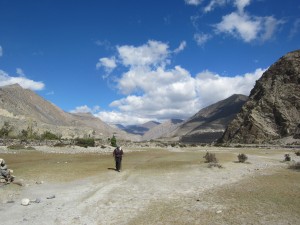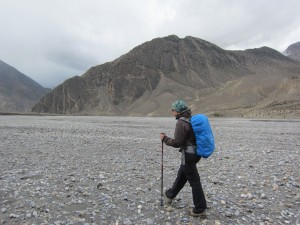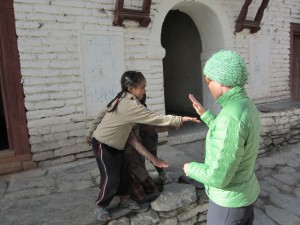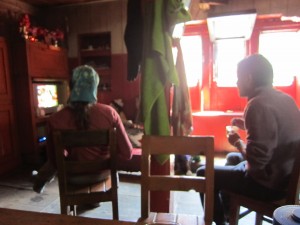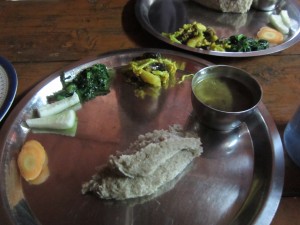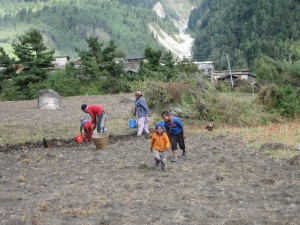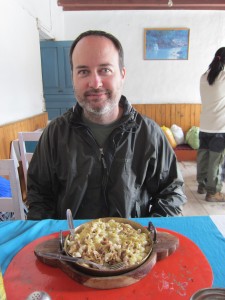The next three days of walking from Kagbeni to Tatopani prove to be some of the most mentally and emotionally challenging for us, as they involve long stretches of hiking along relatively flat desert roads into 60+ KPH headwinds. As before, we leave the jeep road whenever a reasonable opportunity presents itself, and follow the jeep road when there is no viable alternative. We learn quickly that early morning is the best time for walking, as by noon the winds pick up and turn a pleasant walk into a dust-eating slog. We wear hats, sunglasses – I even use my bandana as a dust mask – and it becomes a walking meditation on contemplating being uncomfortable.
At the end of each day the grit has found its way into every possible space (including the camera which jams stuck and refuses to open or close), and we understand why many trekkers opt to take jeep through this part of the trail. We are determined to maintain our claim of hiking the entire Circuit, and so on we slog!
Things get interesting again when we leave Tukuche village (where we had a fun time teaching some kids how to play paddy cake) and detour on a trail on the east side of the Kali Gandaki river. We were the only foreigners on the trail, and we quickly climb above the river valley to the tiny village of Titigaon. There are no shops or guesthouses here. Several children greet us with bright hellos, and then follow up with “Mi thai?” (candy?). Pemba teaches us a useful Nepali phrase: “Mi thai say na”, which roughly means “we have no candy”. It’s a phrase we use often, as mi thai is the most popular request from children.
It’s lunchtime. Pemba asks around and finds a family willing to cook us lunch. We take off our shoes and enter their home, where five children watch TV in the corner. The women head to the kitchen to cook buckwheat mash, a Nepali dish Pemba gives high praise and we have not yet tried.
During the hour while lunch is prepared, we drink tea and watch the program the kids are watching. Since the show is in Nepali, we follow as the plot as best we can: a jungle man, named Eko Eko, goes to Kathmandu, where he is taken in by a beautiful young woman and her little brother. They take him to the mall to shop for modern clothes – jeans, t-shirt, shoes – and he doesn’t know how to wear them. She teaches him how to get dressed and they go to the zoo. He tries to hunt the animals in the zoo (he’s a wild jungle man after all), but the woman stops him, saying “Naughty naughty”. It’s strange to hear a stream of Nepali interspersed with English words. Then the woman and her brother are kidnapped by some thugs, and Eko Eko follows the car to a jungle area, where he rescues them by virtue of his superior jungle skills: shooting arrows, gymnastics and a good amount of swinging from vines. The woman is grateful, but it is time to say goodbye – Eko Eko must go back to the jungle…he looks forlornly at her, and the show ends with a “to be continued…” message. We probably won’t find the sequel on Netflix, but our guess is jungle man and beautiful woman eventually hook up.
Lunch is ready, and delicious. Buckwheat mash is sort of like sticky sour mashed potatoes and is served with similar accompaniments to dal bhat. Tasty. While we eat lunch the women come back in the room and kick the kids outside to play, and then put on their own TV program: a Hindi love story.
We continue on past Titi Lake, which is an anticlimactic experience, as the lake more closely resembles a large puddle. It is supposed to be an important breeding ground for several species of rare birds, but it just looks like a muddy, marshy mess to us. We continue to our night stop of Lete, passing through a couple other small villages and across several landslides that partially block the trail.
From Leti our next destination is Tatopani, which means “Hot water”. We’re told the village has several hot springs where we can enjoy a good soak. We avoid the busy road by taking the old trail, a hilly adventure that takes up and down several ridges. The landscape has become more temperate over the past few days, and we now walk among banana trees, orange trees and waterfalls. We pass a guesthouse that has several tamarillo trees too – a fruit I had not seen outside New Zealand. The owner tells us some New Zealanders brought seeds over twenty years ago. 32 kilometers later, we arrive footsore and weary in Tatopani. This is our longest distance day of our entire trek.
It is dusk and we quickly change into our suits and head for the hot springs with Pemba and Tsering. The hot spring pools are outdoors, a few meters away from the river. The foreigner entrance fee is 50 rupees; Nepalis pay 10 rupees.
And now I face a quandary – how much clothing to keep on? Nepalis are very modest; we haven’t seen couples kiss or even hold hands in public, and most women dress with shoulders and knees covered. Stripping down to my bikini seems immodest – appropriate in Turkey, but not here.
In one pool an Italian woman wears a swim ensemble of black ribbons tied together for strategic coverage. She’s getting a lot of attention from the local guys, but seems clueless. Most foreigner women are in one-piece suits and a few wear shirts over their suits. I look for Nepali women to provide some cultural guidance, but there are none. So I go halfway – I keep a long black shirt on over my bikini, but take off my shorts. The water is hot, and it feels AMAZING to soak our bodies after two weeks of bucket washes and cold showers.
As dusk turned to dark, most foreigners leave the pools. We buy a Sprite from the snack shack and settle in. When it is dark, a new group arrives at the pools: a group of young Nepali women. And what do they wear? Tank tops, t-shirts AND shorts! Ah, everything is relative – a half hour earlier I felt slightly prudish in my ensemble, and now I feel half-naked, which compared to these Nepalis, I am. Mark fits in perfectly in his nondescript shorts, as the dress code for men seems more lax – both local and foreign men wear anything from underwear briefs to knee-length shorts.
We head back to our guesthouse and have a huge dinner of macaroni and cheese, fries, a veggie burger, and yet another plate of oil-popped popcorn. A nice benefit of walking for 4-6 hours each day is that we can pretty much eat whatever we want, and we aren’t gaining weight. If only we could keep this up at home!
